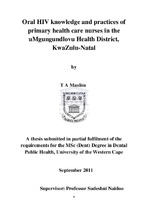| dc.description.abstract | Aim The aim of the study was to determine the oral health knowledge,management and referral patterns of patients with oral manifestations of HIV by Primary Health Care Nurses.Background Nurses working in Primary Health Care (PHC) facilities, and nursing educators, play a pivotal role in the early identification, referral and diagnosis of patients who present for treatment of health problems. They are in an ideal position to identify HIVinfected persons through a simple visual assessment of the mouth, in order to diagnose oral lesions that may be prognostic of HIV, and to then refer these persons for voluntary counselling and testing (VCT). Timely referral will lead to early medical intervention, with lower treatment costs and improved patient quality of life.Methods The study design comprised of a pre- and post-education test, training and provision of educational material, together with a quantitative and qualitative selfadministered questionnaire. The questionnaire gathered information on nurses demographics,experience, knowledge, training and treatment practices.The study design was a cross-sectional survey which was conducted during the period July to October 2010. The study population consisted of 121 nurses based at Primary Health Care and nursing education facilities within the uMgungundlovu Health District in KwaZulu-Natal. The chi-squared test was utilised to determine the statistical significance of the preeducation and post-education test results and Pearsons Correlation Coefficient was used to
determine the significance of correlations between variables. A p-value of <0.05 was regarded as being statistically significant.Results A large number of the respondents did not receive substantial oral health education during both their pre-qualification and post-qualification education stages. Nurses had an inadequate knowledge of oral health assessment and of oral conditions, especially with regard to the common prognostic oral manifestations of HIV. The post-test results were statistically significant (p< .0001), indicating that the provision of education and training to the nurses had a significant impact on nurses knowledge of oral conditions. More than twothirds of the nurses (67,8%) reported that they do not examine the mouth as part of routine overall assessment of the patient, and only 13% referred patients for VCT.Conclusions There is a need to include oral health assessment and oral health promotion into both undergraduate and post-graduate nursing curricula. Further research is needed to identify the specific oral health training needs of all categories of nurses in order to overcome the barriers that prevent nurses from assessing the mouth. Oral health assessment and oral health promotion should become a key part of the curricula of nurses training. The use of oral health promotion workers at a primary health care level should also be considered. | en_US |

